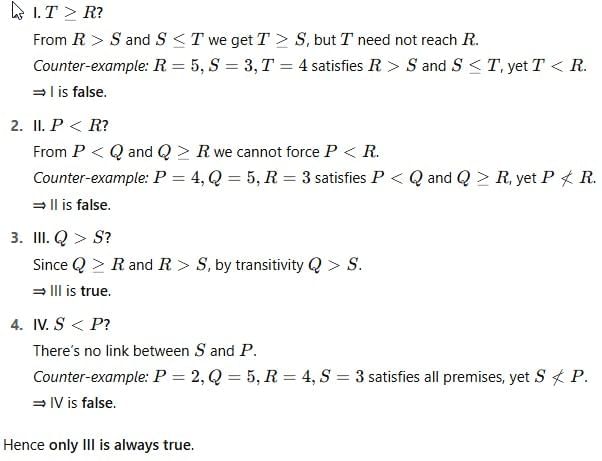Coded Inequalities MCQ - 1 - Bank Exams MCQ
25 Questions MCQ Test - Coded Inequalities MCQ - 1
Statements:
A ≥ B; C > G; A ≥ H;
B ≥ C; I = B
Conclusions:
I. C > H
II. H > B
III. B > G
IV. I > A
II. H > B
III. B > G
IV. I > A
Statements:
A=B; C≤F; G>C; B<F
Conclusions:
I. F < B
II. F > G
III. A > G
IV. A > C
II. F > G
III. A > G
IV. A > C
Statement:- A ≥ B > C = D > E; F > B; Z < D; M > A
Conclusions
a. M > Z
b. M = Z
c. Z > C
d. B = D
Conclusions
a. M > Z
b. M = Z
c. Z > C
d. B = D
Statement :
P ≥ Q > R < S ≤ T
Conclusion:
I. T > R
II. T > Q
III. R < P
IV. Q > P
Statement :
P < Q ≥ R > S ≤ T
Conclusion:
I. T ≥ R
II. P < R
III. Q > S
IV. S < P
Statements:
M<N<O=P; N = Q
Conclusions:
i. P>M, ii. Q<O
Statements:
A>N=I>W<O<P;
O>S; T<N
Conclusions:
i. P>S,
ii. A<W
Statements:
M<P≤G = F≥B; H≥F<I; J≥P
Conclusions:
P≤B, M<H
Statements:
M<P≤G = F≥B;
H≥F<I; J≥P
Conclusions:
H≥J, B<I
Direction(11-15): Study the following information to answer the given questions
A$B means A is not smaller than B A@B means A is neither smaller than nor equal to B A#B means A is neither greater than nor equal to B A&B means A is neither greater than nor smaller than B A*B means A is not greater than B
Statements:
O & A, A $ R, R # S, S * Q
Conclusions:
I. Q @ R II. S @ O
III. R & O IV. R # O
A$B means A is not smaller than B A@B means A is neither smaller than nor equal to B A#B means A is neither greater than nor equal to B A&B means A is neither greater than nor smaller than B A*B means A is not greater than B
Q. Statements:
A * E, E $ F, F # O, O
@ L
Conclusions:
I. L # F
II. E @ O
III. A # O
IV. E @ L
A$B means A is not smaller than B A@B means A is neither smaller than nor equal to B A#B means A is neither greater than nor equal to B A&B means A is neither greater than nor smaller than B A*B means A is not greater than B
Q. Statements:
B @ Q, Q # A, A & L,
L * N
Conclusions:
I. N $ A
II. L @ Q
III. B @ N
IV. Q # N
In the question symbols $, #, % are used for different meanings as follows.
$ means ‘neither greater nor equal to’.
# means ‘neither greater nor smaller than’.
% means ‘neither smaller nor equal to’.
In each of the following questions, assuming the given statements to be true, find out which of the two conclusions I and II given below them is/are definitely true.
Statements: T % I, I # L, L % U
Conclusions: I. T $ L
II. U $ T
A$B means A is not smaller than B A@B means A is neither smaller than nor equal to B A#B means A is neither greater than nor equal to B A&B means A is neither greater than nor smaller than B A*B means A is not greater than B
Q. Statements:
A $ E, E @ F, F * G,
G # H
Conclusions:
I. H @ E
II. A $ G
III. E @ H
IV. A @ F
Directions (Q.No – 16-20) In these questions, relationships between different elements is shown in the statements. These statements are followed by two conclusions.
Q.
Statement:
B≥E<N<Q<R=S
Conclusions:
I. S>E
II.Q<B
Directions: In the following question assuming the given statements to be True, find which of the conclusion among given conclusions is/are definitely true and then give your answers accordingly.
Statements: R ≤ P ≤ Q; R ≥ S > T ≤ M = U
Conclusions:
I. Q > T
II. R ≥ M
In which of these expressions „U > W‟ be definitely false?
Which of the following symbols should be placed in the blank spaces respectively(in the same order from left to right) in order to complete the given expression in such a manner that both „N≥Q‟ as well as „Q≤M‟ definitely holds true? M _ N _ P _ Q _ R
In Which of the following expressions does the expression „D=V‟ to definitely hold true?
Which of the following expressions is true if the expression P<T<=B>S>M>=A is definitely true?
In which of these expressions „S > V‟ and „V > B‟ be definitely false?





















